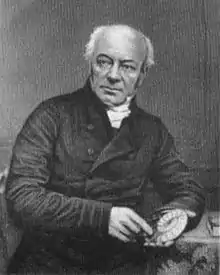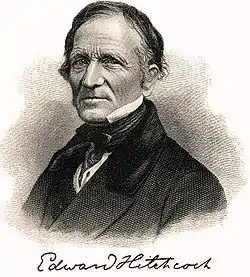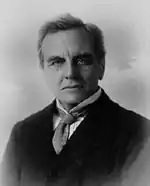19th century in ichnology
The 19th century in ichnology refers to advances made between the years 1800 and 1899 in the scientific study of trace fossils, the preserved record of the behavior and physiological processes of ancient life forms, especially fossil footprints. The 19th century was notably the first century in which fossil footprints received scholarly attention. British paleontologist William Buckland performed the first true scientific research on the subject during the early 1830s.[1]

A slab of Permian-aged sandstone had been discovered in Scotland which preserved a series of unusual footprints. After acquiring the specimen, Buckland experimented with modern animals to ascertain the trackmaker and concluded that the Scottish footprints were made by tortoises.[1] Later in the century famed advocate of evolution Thomas Henry Huxley would refute this attribution and these footprints, called Chelichnus, would remain without an identified trackmaker until scientists recognized that they were actually made by an evolutionary precursor to mammals.[2]
The 1830s also saw the discovery and investigation of unusual hand-shaped footprints from Triassic rocks in Germany that were later named Chirotherium. The identification of the Chirotherium trackmaker proved elusive and suggestions from researchers included everything from monkeys to giant toads and kangaroos.[3] Chirotherium proved to be an enduring ichnological mystery that would not be solved until long into the 20th century.[4]
Some of the most important ichnological research of the 19th century occurred across the Atlantic in the United States. Dinosaur footprints were first discovered there in 1802 when a Massachusetts farm boy stumbled upon bird-like footprints in sandstone that the local clergy mistakenly attributed to the raven that Noah released from his ark during the Biblical Flood.[5] The region's footprints came to the attention of scholars during the mid 1830s when further bird-like dinosaur tracks were discovered elsewhere in the state. These became the lifelong preoccupation of prominent ichnologist Edward Hitchcock. Hitchcock thought the tracks were made by giant flightless birds.[6]
Late in the 19th century prisoners in Nevada discovered a major Ice Age track site at what was once an ancient lake shore. Many of the trackmakers were familiar animals like mammoths or even more modern animals like deer and wolves, but this track site also seemed to preserve the tracks of a sandal-wearing giant.[7] The tracks received significant scholarly and popular attention like satire by Mark Twain who attributed the giant tracks to primitive Nevadan legislators. However, the true identity of the "giant" trackmaker was recognized by paleontologists Joseph Le Conte and Othniel Charles Marsh as a giant ground sloth, possibly of the genus Mylodon.[8]
19th century
1800s
1802
- Spring: A boy named Pliny Moody uncovered a piece of sandstone with mysterious three-toed tracks about 30 cm (1 foot) long while plowing in his father's fields near South Hadley, Massachusetts. The local clergy thought the tracks had been left by the raven that Noah sent out from the ark to look for dry land during the Biblical Flood.[5]
1820s

1820s
- A slab of Permian sandstone preserving 24 small footprints came into the possession of the Scottish Reverend Henry Duncan. Duncan visited the quarry where his slab was originally excavated in Corncockle Muir to see if he could find more of the fascinating impressions and successfully recovered more of them. He notified leading paleontologist William Buckland of Oxford University about his discovery.[9]
Late 1820s
- Fossil footprints were reported from Cheshire, England in Triassic rocks known at the time as the New Red Sandstone. This is the earliest written record of fossil footprints now referred to the ichnogenus Chirotherium.[10]
- A newspaper article was published that discussed fossil footprints, and is now regarded as the earliest written record of the subject.[11]
1830s
- Buckland published the first scientific description of fossil footprints about the tracks discovered at Corncockle Muir. He attributed the footprints to ancient tortoises because after having various modern reptiles walk over stretches of pie crust dough, the tracks left by tortoises most closely resembled those from the Permian sandstone.[11]
- A man named Helmut Barth was building a garden house in Hildburghausen, Germany when he discovered strange, hand-shaped tracks in the sandstone he was using in the construction.[12] Barth's discovery would be named Chirotherium by Johan Jacob Kaup.[13]
- While the streets of Greenfield, Massachusetts were being paved, locals noticed footprints impressed in the stone. The townspeople thought the tracks were left by turkeys.[5] They informed James Deane, a local doctor and naturalist about the footprints. Deane found the tracks intriguing and wrote to another local scholar, Edward B. Hitchcock about the find.[14] Hitchcock spent the rest of the summer investigating the local footprints fossils.[15]
- Edward Hitchcock published the results of his research into the fossil footprints. He thought the trackmakers were large flightless birds.[16]
1840s
- Sir Richard Owen supported Buckland's interpretation of the Corncockle Muir tracks as tortoise tracks and named them Testudo duncani.[11]
- James Deane published the results of his own investigations into the fossil footprints of Massachusetts.[16]
- A man surnamed Cotta wrote a letter including the first documented mention of the many Permian tracks preserved in the "Rotliegendes" of central Germany's Thuringian forest.[19] "Rotliegendes" is German for "red layers" referring to a Permian sandstone layer rich in rusted iron minerals known elsewhere as the "New Red Sandstone".[20] The tracks Cotta reported were later named Saurichnites cottae in his honor.[19]
1850s
- Sir William Jardine argued against Owen's referral of the Corncockle Muir "tortoise" footprints to Testudo because the name applied to a specific group of modern turtles rather than to footprints. He coined the name Chelichnus, meaning "turtle track" to replace Owen's use of Testudo, but preserved the specific epithet "duncani".[11]
- More Permian Chelichnus tracks were discovered in the highlands of Scotland, not far from Cummingstone.[22]
- Samuel H. Beckles began publishing research on the dinosaur footprints from the Wealden, although he did not recognize their dinosaurian origins.[23]
- Beckles continued to publish research on the dinosaur footprints from the Wealden.[23]
- Beckles continued to publish research on the dinosaur footprints from the Wealden, referring to them as Ornithoidichnites following the nomenclature devised by Edward Hitchcock for some American tracks. Despite his use of a term implying an avian trackmaker, Beckles admitted that he did not know what kind of animals made the tracks.[23]
- Edward Hitchcock published a summary of his research into the fossil footprints of the Connecticut Valley area. He continued to attribute the tracks to large flightless birds that he named their footprints "ornithichnites", meaning "stone bird footprints". He divided the trackmakers into two groups, the leptodactylous birds with narrow toes and the pachydactylous birds with thick toes. He also described seven new ichnospecies for the tracks he studied.[16] He also described the ichnogenus Grallator.[24]
1860s

- A British scientists surnamed Williamson interpreted the Chirotherium trackmaker as a crocodile.[25]
- Oppel interpreted some tracks from the Solnhofen lithographic limestone as the tracks of pterosaurs.[26]
- Edward Hitchcock died.[27]
1870s

- Thomas Henry Huxley argued against Buckland and Owen's attribution of Chelichnus duncani to ancient tortoises, instead concluding that it was impossible to identify the trackmaker with the knowledge of time.[22]
- Some Welsh dinosaur tracks that had been previously displayed in front of the Jolly Sailor Pub in Newton Nottage were acquired by the Cardiff Museum.[28]
- T. H. Thomas reported the Welsh dinosaur footprints to the scientific literature and noted their similarity to the "Ornithichnites" of Connecticut.[28]
- W. J. Sollas independently published a report of the Welsh dinosaur footprints.[28]
1880s

Early 1880s
- Inmates of Nevada State Prison uncovered a large Pleistocene fossil track site while excavating sandstone. The track sites was a lakeshore 50,000 years ago where familiar Ice Age animals like birds, deer, mammoths, and wolves left behind their footprints. However, ten of the roughly 50 trails seemed to have been left by an even stranger trackmaker; a sandaled giant.[7]
- George Le Mesle and Pierre Peron discovered dinosaur footprints in Algeria. These were the first fossil dinosaur tracks to be discovered in Africa.[29]
- Large theropod footprints were reported in Late Jurassic rocks at Cabo Mondego, Portugal. These may have been the first European Late Jurassic dinosaur footprints to be documented in the scientific literature.~152~
- W. P. Blake reported the fossil footprints discovered at the prison in Carson City, Nevada to the scientific literature.[30]
- Mark Twain wrote the satirical "The Carson Fossil Footprints" attributing the purported giant tracks discovered there to primitive members of the territorial legislature.[31]
- A Mr. C. Pooley discovered a small five toed fossil footprint in Oxfordshire, England, which preserved in a Middle Jurassic stratigraphic unit called the Stonesfield Slate.[32]
- John Eyerman discovered two slabs of rock preserving fossil dinosaur footprints near Milford, New Jersey. The trackmaker was probably a small, quadrupedal ornithischian dinosaur.[33]
- Addison Coffin drew up a map of a large portion of the Pleistocene Carson City tracks.[34]
- Dinosaur footprints were discovered near Goldsboro, Pennsylvania. These tracks are now classified in the ichnogenus Atreipus.[35]
1890s
1890s
- Othniel Charles Marsh described the new ichnogenus Limnopus for Carboniferous tracks from the coal beds of Kansas.[37]
- A geology professor named James A. Mitchell discovered some small Grallator tracks in the Late Triassic Gettysburg Formation of Maryland. These are the first and only known dinosaur tracks in the state.[38]
See also
- History of paleontology
- Timeline of ichnology
Footnotes
- Lockley and Meyer (2000); "Earliest Discoveries," pages 25–27.
- Lockley and Meyer (2000); "Earliest Discoveries," pages 27–28.
- Lockley and Meyer (2000); "The Story of Chirotherium: The Dawn of the Archosaurs," pages 54–55.
- Lockley and Meyer (2000); "The Story of Chirotherium: The Dawn of the Archosaurs," pages 57–58.
- Weishampel and Young (1996); "Footprints in Stone," page 58.
- Weishampel and Young (1996); "Footprints in Stone," pages 58–60.
- Lockley and Hunt (1995); "The Case of the Carson City 'Man Tracks'," page 277.
- Lockley and Hunt (1995); "The Case of the Carson City 'Man Tracks'," pages 278–279.
- Lockley and Meyer (2000); "Earliest Discoveries," page 25.
- Lockley and Meyer (2000); "The Story of Chirotherium: The Dawn of the Archosaurs," page 53.
- Lockley and Meyer (2000); "Earliest Discoveries," page 27.
- Lockley and Meyer (2000); "The Story of Chirotherium: The Dawn of the Archosaurs," pages 53–54.
- Lockley and Meyer (2000); "The Story of Chirotherium: The Dawn of the Archosaurs," page 54.
- Weishampel and Young (1996); "Footprints in Stone," page 59.
- Weishampel and Young (1996); "Footprints in Stone," pages 59–60.
- Weishampel and Young (1996); "Footprints in Stone," page 60.
- Weishampel and Young (1996); "Theropoda: Skeletons. Fires, and Footprints," page 113.
- Lockley and Meyer (2000); "1. What Are the Correct Ichnogenus and Species Names to Use for These Tracks?" page 195.
- Lockley and Meyer (2000); "Rotliegendes: Permian Trackway Heaven," page 39.
- Lockley and Meyer (2000); "Rotliegendes: Permian Trackway Heaven," page 38.
- Lockley and Meyer (2000); "Tracking in the Holy Cross Mountains, Poland," page 118.
- Lockley and Meyer (2000); "Earliest Discoveries," page 28.
- Lockley and Meyer (2000); "Iguanodon and Conan Doyle's Lost World," page 201.
- Weishampel and Young (1996); "Theropoda: Tracking and Attacking in the Triassic," page 98.
- Lockley and Meyer (2000); "The Story of Chirotherium: The Dawn of the Archosaurs," page 56.
- Lockley and Meyer (2000); "Turtles and Hopping Dinosaurs," page 178.
- Weishampel and Young (1996); "Footprints in Stone," page 61.
- Lockley and Meyer (2000); "Welsh Dinosaurs at the Jolly Sailor Pub," page 79.
- Moore (2014); "1880" (2), page 90.
- Lockley and Hunt (1995); "Chapter 6: The Cenozoic Era," page 321.
- Lockley and Hunt (1995); "The Case of the Carson City 'Man Tracks'," page 279.
- Lockley and Meyer (2000); "Mr. Pooley's Enigmatic Track Discovery," page 143.
- Weishampel and Young (1996); "More Early Footprints," page 62.
- Lockley and Hunt (1995); "The Case of the Carson City 'Man Tracks'," page 280.
- Weishampel and Young (1996); "More Early Footprints," page 63.
- Lockley and Meyer (2000); "Dinosaurs in the Great Deltas of Yorkshire," page 133.
- Lockley and Hunt (1995); "Interpreting Tracks and Track Habitats," page 51.
- Weishampel and Young (1996); "More Early Footprints," pages 62–63.
References
- Lockley, Martin G.; Hunt, Adrian (1995). Dinosaur Tracks of Western North America. Columbia University Press.
- Lockley, Martin G.; Meyer, C. A. (2000). Dinosaur Tracks and other fossil footprints of Europe. New York: Columbia University Press. ISBN 0-231-10710-2.
- Moore, Randy (2014). Dinosaurs by the Decades: A Chronology of the Dinosaur in Science and Popular Culture. Santa Barbara: Greenwood. p. 472. ISBN 978-0-313-39364-8.
- Weishampel, David B.; Young, L. (1996). Dinosaurs of the East Coast. Johns Hopkins University Press.
External links
- *
 Works related to Ichnology at Wikisource
Works related to Ichnology at Wikisource


_-_close-up.JPG.webp)
